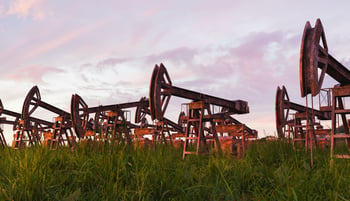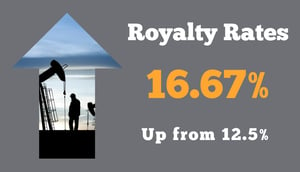
Land teams know just how hard and competitive it is to acquire prime acreage to drill a new well. That's why lease terms for private land typically have at least a 15% royalty rate and attractive bonuses for landowners. However, next door on an adjoining tract of federal land, lease terms are very different. Though the industry has long benefited from an inflexible and poorly maintained federal leasing system, recent legislation and public perception have led to important changes to how operators acquire an onshore federal lease and pay Uncle Sam.

2022's Inflation Reduction Act outlined changes to federal leasing that were finalized and announced this April and have recently gone into effect as of June 22, 2024. With royalty rates that had not changed in 100 years, bonding requirements that had not changed in 60 years, and minimum bids unchanged for decades, the system was long overdue for a complete overhaul to ensure taxpayers are fairly compensated and not left paying for orphaned wells to be cleaned up and plugged.
Let's walk through the changes to bidding, bonding, rental rates, and royalties so your team can better navigate federal leases in hot spots like the Delaware Basin and other places with prime federal acreage. While these rules have changed drastically, rules for reinstating a federal lease once you've missed a payment are still like a game of Chutes and Ladders - make one misstep, and you're back to the starting point. Read on for a review of the two types of reinstatement and some best practices.
Bidding for Federal Leases
Since the late 1980's, the minimum bid for federal land was only $2 per acre. Of course, a lot of inflation has happened in the last three decades, and like all aspects of federal leasing, the government took too long to match bidding minimums to today's economic environment. Under the new rules, noncompetitive bids are no longer allowed. The minimum bid is $10 per acre, plus a $5 per acre filing fee. The minimum bid could also be adjusted periodically for inflation.
Covering the Cost of Abandoned Wells

Oil & gas companies are required to post a bond to cover the cost of decommissioning a well if the operator is not able to meet this obligation, e.g., after a bankruptcy. Research from the journal Environmental Science and Technology estimates the median cost to be $76,000. However, the last change to the lease bond requirements made in 1960 fixed bonding at only $10,000 for the last 63 years. This has left Uncle Sam and taxpayers on the hook for plug and abandonment. After acquiring a federal lease, operators are now required to pay a $150,000 lease bond plus a $500,000 statewide bond, up from $25,000. This should be more than enough to cover even today's multi-well pads if ever abandoned. Additionally, the updated federal leasing rules no longer require nationwide or unit operator bonds.
The New 16.67% Royalty Rate

For more than a century, the royalty rate for onshore federal lands has been set at 12.5%, below market average with the fierce competition for remaining inventory. Though still viewed as too low by some industry outsiders who point to the offshore rate of 18.75%, the increase was nonetheless late to the game. However, provisions built into the new rules allow for the rate to increase after 10 years.
Lease Rental Payments
The last change to the federal lease rules concerns lease rentals. The new rate is now $3 per acre, up from $1.5. However, instead of remaining fixed over the life of a lease, the rental rate increases over a 10-year period. Operators will pay $5 per acre between years three (3) and eight (8) and then $15 per acre thereafter.
Reinstating a Federal Lease
Once you've written out a check to the regional BLM office where your federal lease was signed, all future payments must be diligently made to the Office of Natural Resource Revenue (ONNR). This process and the steps for reinstating a federal lease are still as treacherous as before should a payment be missed. The law requires immediate termination of a lease if the annual rental payment is not timely received, and there are no grace periods, notices, or warning letters from ONNR. The BLM is simply the bearer of bad news and has no authority to reinstate the lease. That said, reinstatement is possible but depends on which way the political winds are blowing in Washington, D.C. The Secretary of the Interior has sole discretion to approve or deny a lease reinstatement. In a bureaucratic environment, there isn't even an official form to fill out.

The Type I Reinstatement is the preferred path back to the graces of Uncle Sam, requiring that an operator make their case to the Secretary of the Interior within 20 days of missing the anniversary date of the lease and rental payment if the failure to file was justified or not due to a lack of reasonable due diligence, all subjective depending on who's sitting in the Secretary's chair. The punitive Type II Reinstatement modifies the terms of the lease to four (4) points above the original lease royalty rate, but no less than 20%, and changes the rental rate to $20 per acre if the operator fails to act within 20 days of missing the payment. Under the new rules, noncompetitive leases are not eligible for reinstatement unless they are part of BLM Acquired Lands.
Reinstatement notwithstanding, the steps taken to modernize the federal leasing system should have a net benefit for everyone involved, even though operators are being asked to pay more. With appropriately priced bidding, bonding, royalties, and rentals, taxpayers benefit, and we affirm our commitment to good environmental stewardship. As such, the oil and gas industry’s reputation improves among the communities in which we operate.
PakEnergy’s land management software helps land teams manage federal leases with ease and precision. Powerful yet intuitive, our industry-leading eCalendar tracks federal leases and implements controls to help you avoid missing critical expiration dates and lease payments. Plus, our ONNR reporting simplifies and accelerates compliance, enabling your team to de-risk and avoid the uncertainty and cost of reinstating a federal lease.
Learn more about the recent Federal Lease changes and how to navigate them successfully. Watch the "Unraveling the Changes in Federal Leases & the Inflation Reduction Act" webinar. BONUS: Grab your complimentary copy of our "Navigating the New Federal Oil & Gas Leasing Landscape" resource guide.

Amy Hopmann, CPLTA serves as Vice President of Customer Success & Land Outsourcing at PakEnergy. With over 25 years of experience in Land Management and Administration, Amy has deep expertise in land and lease management and best-in-class owner relations practices. Her passion for elevating the customer experience and optimizing their operations has been key to her success in the oil and gas industry. Amy is a respected and engaged leader and enjoys mentoring and developing her teams to deliver outstanding consultative services and support to both internal and external stakeholders. A Certified Professional Lease & Title Analyst, Amy is a frequent speaker at industry events and served as President of NALTA (National Association of Land Title Analysts) from 2016-2017. Reach out to her at Amy.Hopmann@PakEnergy.com.

